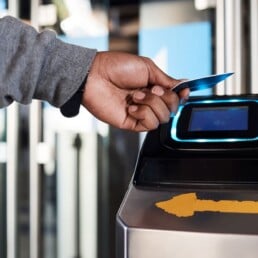Why Aren't We There Yet?
Despite a big wave of RPA implementations, the back-office is often left behind in enterprise-wide digital transformations. Today, back-offices continue to be plagued by manual, repetitive processes. The complexity of these operations is now further compounded by the exploding data generated, stored, and consumed. Fortune 500 firms lose an average of $480 billion a year due to inefficiencies, mostly in the back-office.(1) So what is preventing so many financial institutions from digitizing their back-office?
The status quo: Focus on customer experience over satisfaction
Simply put, industry dynamics have forced investments to be focused on “above the glass” enhancements to customer experience while postponing much-needed digital back-offices. Frequently, financial institutions tend to fall victim to the misconception that there is no immediate business case for back-office upgrades. This assumption fails to fully consider the immediate benefits of redeploying personnel, improving efficiency, and optimizing processes.
Exhibit 1. Shrinking Investment in the back-office
Market Digitization Landscape
There is a broad spectrum of both progress towards and commitment to end-to-end digitization within the market currently:
1. Initial digitization: These firms have typically completed some level of customer-experience-focused transformation (e.g., digital interfaces) in their front office, but are still characterized by mostly manual middle and back-offices. This often entails manual processes such as emails being sent back and forth and/or physical paper being scanned to share information. These processes are time-consuming, repetitive, and require multiple systems and touchpoints.
2. Evolving digitization: Like initial state FIs, these institutions tend to have fully digital front offices with enhanced CX, and often have some degree of digital tool use in their middle office (e.g., API connectivity between systems, automated translation of customer inputs and requests from digital channels) as well. However, their back-offices remain manual, posing the risk for delays and re-submissions that can impact customer satisfaction.
3. Advanced digitization: Advanced stage FIs are almost completely digital as it pertains to customer touchpoints and have significant digitization in their middle and back-offices. There is limited paper being used, API connectivity between system and applications, and almost no manual keying in of input by personnel. Document creation is either natively digital or involves instant digitization, ensuring a satisfactory customer experience from end to end.
Exhibit 2.Stages of Digitization
Customer Experience Vs. Customer Satisfaction
It’s important to delineate between customer experience (CX) and customer satisfaction. Digitization has thus far indexed heavily on customer experience, which refers to the impression left on the customer based on interactions with financial institution.
This includes digital interfaces, savvy UI, and seamless transitions between form factors.
While customer experience is no doubt important, customer satisfaction typically plays a more profound role in the overall relationship, as it refers to a customer being satisfied with the comprehensive outcome, as opposed to individual interactions.
For example, an FI may have a delightful user interface, but if underlying data is not tagged and leveraged in a compliant yet shareable manner across the enterprise, the customer will have to resubmit the same documents, and their overall satisfaction will likely be low. As such, investments focused only on front office digitization fail to consider the larger picture.
Exhibits 3 & 4 demonstrate the gap that often exists between internal and external perceptions of customer experience delivery.
This gap is largely due to the fact that customers index on customer satisfaction, evaluating their overall experience in a more comprehensive manner.
Exhibit 3. Legacy FI Customer Experience Gap
Exhibit 4. Gaps across key dimensions
What Does The Prize Look Like?
While digitally transforming the back-office may pose some challenges, the benefits far outweigh the costs; digitizing, automating, and optimizing document-related workflows is estimated to reduce costs by more than 35%, reduce time spent on document-related tasks by 17%, and reduce errors by almost 52%.(2)
Considering that over $600 billion in costs across industries can be attributed to data entry errors, a 52% reduction has a noticeable impact.(3)
Further, banks that have undergone successful digital transformation have seen up to 4x acceleration in the delivery of new products and services, which is a direct result of noticeable (20-30 points) improvements to customer satisfaction scores.(4)
These back-office digitization benefits are quantitative, significant operational expenditure and revenue expansion opportunities.
The advantages can be bucketed into four main categories as outlined in Exhibit 5 to the right.
Exhibit 5. Advantages to Back-Office Digitization
But it ain't easy
Exhibit 6. Back-office Digitization Challenges
If the impact to customer satisfaction is so clear, what is preventing FIs from investing in digital transformation? The heterogenous nature & structure of inbound channels makes progress inherently difficult for many reasons:
1. Customer data intake often occurs in an omnichannel fashion through a difficult-to-streamline mix of physical and digital sources. For example, an onboarded customer may fill out a digital intake form but provide a photo of their ID via email.
2. Data intake often entails complex, multi-touch routes For example, to process a single auto loan, a bank must coordinate with the dealer and customer to receive a loan application, verify documents, underwrite loan risks, communicate loan terms, disburse loan funds, transfer vehicle title to the customer, and set up loan payments. These complicated processes are incredibly paper-heavy, manual, and therefore time-consuming.
3. There are ever-increasing regulatory compliance guidelines (e.g., BASEL, AML, NIST, GDPR, ISO-27001) that are already estimated to account for 10% of a typical bank’s overall operating costs(5); therefore, further compliance penalties resulting from process change management can be understandably deterring.
How Should You "Not" Approach It
Typically, organizations embark on their digitization journey with a myopic focus on ROI, employing a cost-to-savings matrix approach to segregate initiatives.
While the cost-to-savings matrix approach may yield quick wins in the form of incremental efficiency gains, it is fraught with several inherent drawbacks that undermine its long-term viability:
Enterprise ROI Optimization:
Attempting to avoid siloed optimization, businesses often focus on maximizing organizational level ROI from day one, considering enterprise-wide solution applicability to individual business units secondarily.
However, counterintuitively, we have seen lower success with firms succeeding in this sequence, as it fails to consider the challenges in obtaining LOB-specific stakeholder buy-in, aligning financial budgets across LOBs, and deployment constraints.
Prioritization based on Misleading Indicators:
Rather than using broad indicators as signals to shortlist processes and then methodically arrive at processes with ROI for digitization, enterprises often hastily digitize processes with a high degree of paper jams or human efforts involved.
This fails to consider other key parameters, such as impact on end-customer experience, criticality to business, applicability/scope of expansion to other business units, etc.
Deferred Transformation:
Although there is clear consensus on the high ROI potential of long-term initiatives, they often get relegated to the backseat due to the sheer costs involved, time to realize benefits, and level of foundational changes required. Most often, these transformational initiatives are what stands between delivering good customer experience in bits versus ensuring high overall customer satisfaction. This shortsightedness not only stifles future growth, but also increases the complexity and cost of future transformation endeavors.
Ignoring Readiness:
Deploying ostensibly easy-to-implement solutions without due consideration for readiness levels (technological, organizational, process, financial) can lead to resistance, inefficiencies, and suboptimal long-term ROI.
Exhibit 7. Conventional Approach to back-office Digitization
How To Get It Right
To address these challenges and steer toward sustainable success, organizations must:
- Solution individual LOBs first and then expand (versus the converse)
- Prioritize use cases based on benefits beyond immediate operational savings (versus misleading indicators)
- Innovate designs for modularity, agility and efficiency (versus point solutions)
- Customize digitization journey based on readiness levels (versus ad hoc implementations)
Let us dive deeper into each of these guiding principles:
1. Solutioning individual LOBs first
In theory, maximizing enterprise-wide ROI by solutioning across the enterprise with potential synergies and economies of scale would be the right approach.
The problem with this enterprise approach is that the onus of digitization then lies with the CIO’s office.
This path is riddled with challenges as the broad mandate is difficult to execute considering specific goals and targets of individual business units.
However, we have seen digitization efforts gaining success when deployed within an LOB, contained within a cost center, and then expanded to other LOBs.
The recommended approach would be to target use case(s) within a specific LOB, fix issues with ease, and deploy solutions contained in the same cost center.
Further, contained implementations also provide a better line of sight into customer satisfaction, identifying learnings that can be extended to the broader organization.
Upon successful implementation, the solution can be extended as needed through in-house efforts or partnerships with external players.
2. Prioritizing use cases with benefits beyond immediate savings
There is no denying the fact that a high degree of manual effort, physical paper documents, and repetitive data exchange are strong indicators of areas that can benefit from digitization.
However, following these signals alone to develop one’s digitization journey map might dampen the ROI, as there are use cases that can hugely benefit from digitization in other ways beyond these direct operating expense savings.
The most pertinent examples are revenue-side benefits such as better up-sell/cross-sell potential due to improved customer satisfaction, quicker time to market, product differentiation and indirect cost savings like reusability/applicability of solution to other use case(s) or LOB(s) and so on.
Not to mention the fact that factors such as feasibility (technology, operational) and investment requirements need to be incorporated while scoring and prioritizing use case(s).
Exhibit 8. Use-case Prioritization
3. Innovating designs for modularity, agility and efficiency
In all fairness, there has been digitization of back-office processes across accounting and finance, transaction processing, underwriting and risk management, customer service, compliance and regulatory reporting over the past few years. However, such digitization has often been unstructured, and the presence of legacy systems, paper-heavy manual processes, strict regulations, and high cost of error still hinders effective digitization.
Under such conditions, innovating design to be modular, agile, and efficient is crucial. Most FS back-office processes follow a standard flow that begins with incoming data from different channels and sources being received by back-office staff. It is then processed based on established rules, and often in collaboration with cross-functional teams. The processed output is then used for downstream purposes (e.g, sending output to customer, reporting). Finally, the data is archived to generate insights and for regulatory purposes.
For example, a bank loan application’s data inputs could be paper documents (application and proofs) in the case of in-person branch visit, or digital files from a digital application. Relevant information from the paper is manually validated and entered in a loan origination or management system (LOS/LMS).
Information processed in these systems is used across teams (e.g., underwriting, risk management, compliance, regulatory reporting) and is taken by the customer service team to request further proofs, or to communicate the sanctioned loan amount and terms. Only a digital back-office would allow different teams to glue things together to satisfy customer needs effectively and avoid the large degree of back and forth that this complex process would otherwise require.
Designing different components of this back-office involves careful consideration of the following:
1. Data inputs: As incoming data arrives from different channels (e.g., fully digital, “phygital”, paper documents) with different levels of sensitivity (incl. PII), the data ingestion mechanism must be comprehensive enough to handle wide spectrum of:
- Data types: structured, semi-structured and unstructured
- Data sources: paper documents, PDFs, images, excel files
- Data channels: digital (bulk uploads, portals, emails), scanned paper documents, mobile application, fax
2. Core Processing Engine: The effectiveness of an FI’s processing engine largely depends on:
- Intelligent processing capabilities: The industry is shifting from basic optical character recognition (OCR) based processing towards advanced AI/ML based intelligent document processing (IDP) and NLP based customer service. Enterprises should be open to partnerships with relevant startups if they lack necessary expertise in-house and/or need faster deployment
- Taxonomy and Rules Engine: Extracted data needs to correctly classified and categorized. Thereafter, workflows need to be configured based on rules. Using both standard taxonomy and rules for cross-use cases/LOB application and specific taxonomy and rules customized to specific use cases/LOB is key for successful deployment.
- Process automation: Lastly, workflows need to be automated allowing for human in the loop (HITL) layer to accommodate manual checks for exception handling
3. Integrations: Effective functioning of the core processing engine requires seamless integration through:
- 3rd party APIs: to connect with required 3rd party systems (e.g., PEP data bases for KYC checks)
4. Customizing digitization journey based on readiness
To kickstart digitization, it is imperative for FIs to customize plans based on technological, organizational, and financial readiness.
i. Tech Readiness
This involves understanding share of legacy to modern systems, feasibility of modernization, and complexity of integrations involved. Organizations must also assess their degree of decoupled architecture to gauge agility and flexibility in deploying digital solutions. Evaluating partnerships and integration feasibility becomes crucial, as does ensuring the impact of digitization on data security, compliance, and regulatory reporting standards.
ii. Organizational Readiness
Often, the type and number of resources for back-office processes changes with digitization. Therefore, assessing an organization’s appetite for change based on past experiences becomes key. Moreover, aligning digitization initiatives with leadership priorities ensures strategic alignment and support, while addressing the ability to maintain business as usual (BAU) operations during the transition period increases organizational confidence and probability of success.
iii. Financial Readiness
Financial readiness assessments involve a comprehensive analysis of existing investments, budget allocation, and financial goals. Organizations must conduct a thorough examination of investments already made and subsequently estimate the expected payback period in order to measure ROI. Further, considerations such as budget allocation and preferences towards capital versus operational expenditure help inform investment strategies and assist with decision-making as final approvals are sought from a cross-functional leadership body.
Exhibit 9. Digital back-office Design [Sample]
Exhibit 10. Readiness Assessments
In Closing...
End-to-end digital transformation is a prerequisite for long term success for financial institutions. To stay competitive, retain customer loyalty, and move the needle from customer experience to customer satisfaction, financial institutions need to digitize their back-offices as soon as possible. And while there are plenty of obstacles that accompany this transformation (e.g., channel complexities, low perceived ROI, stringent regulations), digital back-offices allow for the optimization of resources, improved efficiency, bolstered customer satisfaction, and leveraging of emerging technology.
Financial institutions should aim to digitize aggressively, whether that be solutioning on an individual LOB level and expanding, prioritizing use cases based on perceived returns, taking a modular but agile approach to innovation, or customizing based on overall readiness.
The status quo has too long indexed on customer experience as the dominant consideration for digitization. Customers are no longer fooled by fancy UI; they are more focused on their overall satisfaction. Further, rapidly emerging technology and innovation will not adapt to accommodate legacy systems and institutions. It is time for FIs to move past the reactive environment where “above the glass” enhancements to customer experience are considered sufficient and begin tackling their digital back-office transformations.
__________________________________________________________________________________________________________
- SSO Network
- Mely AI
- Itemize
- Horne Insights
- Lexis Nexis






































